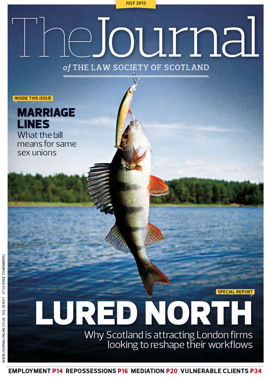Beneath the surface

The guidance from the Law Society of Scotland regarding contaminated land is clear. The basic position remains as per the Society’s Guidance of April 2003, as amplified (Journal, March 2011, 56: www.journalonline.co.uk/Magazine/56-3/1009442.aspx), i.e. if a solicitor does not exclude the liability for environmental law matters, and/or contaminated land matters in the initial terms of business issued to the client, then that solicitor is obliged to provide advice regarding contaminated land matters as per the Guidance. If that solicitor does not feel qualified to comment regarding environmental matters and/or contaminated land matters, he or she is entitled to exclude responsibility for such matters by so doing in the initial terms of business issued to the client.
The reality is, however, that contaminated land is the legacy of Scotland’s industrial and commercial past. It will not simply go away, and that legacy will continue to cost money – in some cases substantial sums of money. Consideration of two examples may help.
Reasonable, but not enough
The first is an example of very substantial liability from a couple of years ago. The former Steetley Chemicals Works site is located at Sandridge, near St Albans in England. It was owned and operated for around 30 years by Redlands Minerals (formerly known as Steetley Chemicals), and manufactured, among other things, a substance called potassium bromate. In 1983 the site, no longer used for chemical manufacturing, was sold to Crest Nicholson to be redeveloped for housing.
Crest Nicholson was aware of some contamination on site, and accordingly developed a remediation strategy in co-operation with St Albans District Council, the local planning authority at the time. The site was remediated in a manner which was thought appropriate at the time. Crest Nicholson then built on the site a development of 66 homes with car parking and landscaped areas.
So what went wrong? In 2002, Crest Nicholson was contacted by the English Environment Agency and advised that groundwater contamination had been identified beneath the development, along with a significant ground water contamination plume consisting of bromide and bromate. These substances were having an impact on local drinking water supplies. The site was designated as a contaminated land site by the local authority in 2002, and later that year as a “special site” requiring regulation by the Environment Agency under Part IIA of the Environmental Protection Act 1990.
The primary liability for contaminated land in terms of Part IIA is imposed on those who are determined to have caused or knowingly permitted the presence within the land in question of the substances by reason of which the land is deemed to be contaminated land. Following extensive, complex and expensive procedures, it was established that both Crest Nicholson and Redland Minerals were the “appropriate persons” under Part IIA, and liability was divided between then. Some reports indicate that the overall cost of the remediation is expected to be at least £16 million.
What is the point to the story? The point is that the chemical works was remediated to what was regarded as a reasonable standard at the time, but notwithstanding that, very substantial cleanup costs have been imposed on the party that sold the chemical works and the builder that redeveloped it, more than 25 years after the development took place.
These are large and scary figures about a recognised chemical works located far away from Scotland. Our second example is closer to home and on a more human scale, which, perhaps, serves to make it of greater concern.
Spectre from the 19th century
Blanefield is a very pleasant village to the north west of Glasgow. What is not readily apparent if you visit the village today is that during the 19th century it was home to a very substantial calico printing works, which at its peak may have employed 500 men, women and children. By the end of that century the calico printing trade had an overcapacity of factories and, accordingly, the printing works was closed down. By 1910 the last of the buildings had been demolished. The world moved on and probably most people forgot that the printing works had ever existed. Once again, however, the legacy of our industrial and commercial past has come back to haunt us and cost us money.
A problem became apparent when a soil analysis carried out by the local authority in 2012 found traces of lead and arsenic left over as a legacy of the printing process.
My understanding is that this situation is still developing and final decisions have yet to be taken. The basic decision is, however, whether or not the ground in question is “contaminated land” as defined by Part IIA. Part of the definition of contaminated land as contained in Part IIA is that it is “land which appears to the local authority in whose area it is situated to be in such a condition by reason of substances in, on or under the land, that (a) significant harm is being caused or there is a significant possibility of such harm being caused”. My understanding is that the local authority believes, based on the scientific outcomes of their investigation of the ground and risk assessment, that there is evidence that the land is in such a condition that it presents a “significant possibility of significant harm” to human health.
If a determination is made that land is contaminated land, then, as mentioned above, the primary liability for contaminated land in terms of Part IIA is imposed on those who are determined to have caused or knowingly permitted the presence within the land in question of the substances by reason of which the land is deemed to be contaminated land. Unfortunately, however, in this particular case, we are talking about a factory which was demolished more than 100 years ago. My understanding is that the council has been unable to identify any party who “caused or knowingly permitted” the presence of the substances in question, because the owners of the printing works went out of business over a century ago with no indication of a parent company or successor, and the council has no evidence that any of the developers who built the dwellinghouses on the site knew about the contamination.
Part IIA provides that in the absence of a causer or knowing permitter, the liability falls upon the owners or occupiers of the site. The appropriate persons may accordingly be the owners of a group of 13 homes which are affected by the lead and arsenic contamination. Unfortunately, the latest estimate of the cost of remediation to these 13 gardens is almost £600,000 (and ironically a large proportion of this cost is landfill tax). Accordingly, if the liability was divided among the proprietors of the 13 gardens, then each proprietor would be looking at a bill of many tens of thousands of pounds.
Luckily for the various proprietors, the relevant statutory guidance provides (at E44 and E45) that where an appropriate person of this kind owns and occupies a dwelling on the contaminated land in question, the enforcing authority should consider waiving or reducing its cost recovery where that person satisfies the authority that at the time he purchased the dwelling he did not know and could not reasonably be expected to have known that the land was adversely affected by the presence of a pollutant. It further provides that any such waiver or reduction should be to the extent needed to ensure that the person in question bears no more of the cost of remediation than it appears reasonable to impose having regard to his income, capital and outgoings.
Hopefully, the local authority will accept that it is unreasonable to impose these costs on innocent purchasers of these dwellings. I understand that a final decision is still to be taken.
Decision time
However, the lesson is clear. This whole issue is not going to go away. It will continue to cause problems. If solicitors wish to advise about contaminated land, reference could be made to my article at Journal, May 2003, 65 (www.journalonline.co.uk/Magazine/48-5/1000174.aspx). That lists the principal mechanisms by which action can be taken regarding contaminated land. If solicitors do not wish to advise about environmental matters and/or contaminated land matters, then, as mentioned above, they are entitled to exclude responsibility for such matters by so doing in the initial terms of business issued to the client. The one option which is not available is simply ignoring the issue and hoping it will go away.
CML adds “Green Deal” condition
The Council of Mortgage Lenders is to include new rules in its handbook on “Green Deal” plans for properties, adding to the checks to be carried out by solicitors with effect from 8 July 2013.
A UK Government scheme, the Green Deal enables householders and businesses to make energy-saving improvements – adding a facility such as solar panels, or installing insulation or double glazing – without having to pay all the costs up front.
Instead, the money is paid off in monthly instalments via the electricity bill. Because it is the property that benefits, the additional payments transfer to any new owner until the costs, which include interest, are paid off.
Under the CML rule changes, solicitors will have to check whether they are required to disclose details to lenders about Green Deal plans for energy technologies which have been installed on residential properties.
The Law Society of Scotland has advised that practitioners should consider adding this question to any property questionnaires they use, and ensure that the existence of any technologies is commented on by surveyors.
In this issue
- Credit hire: back to basics
- You know who I mean
- Behind all the fun
- Your Future in Law
- Reading for pleasure
- Opinion column: Cameron Fyfe
- Book reviews
- Profile
- President's column
- Mapping out the Crofting Register
- Back office bait
- Another bite at the cherry
- Security of your home
- Marriage redefined
- Building better business cultures
- Keeping a rein on child cases
- Minimum gain
- Beware LLP tax changes
- Framework remodelled
- Scottish Solicitors' Discipline Tribunal
- A Scottish ILG chair in New York
- Beneath the surface
- Being alert to the needs of the vulnerable
- Sins of our leaders
- How not to win business: a guide for professionals
- Litigation: a tight ship?
- Ask Ash
- Why sep rep?
- From the Brussels office
- Law reform roundup
- Diary of an innocent in-houser






